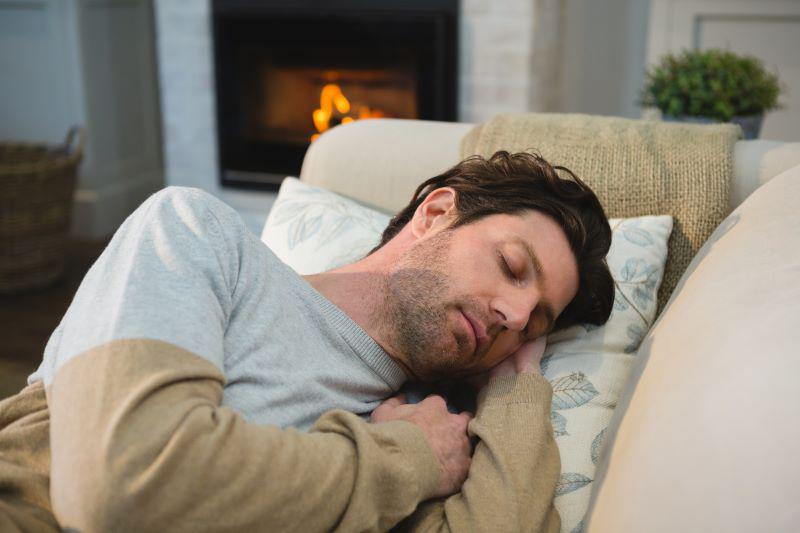Get Healthy!

- Alan Mozes
- Posted May 15, 2023
Looking for Inspiration? A Short Nap Might Help
Lightbulb inventor Thomas Edison believed a little shuteye could boost his creativity. Contemporary scientists think the iconic innovator was on to something.
But timing is key, they say.
"We found a strong effect of 'sleep onset' on creativity,"said study author Kathleen Esfahany, an undergraduate student focusing on computer science and neuroscience at MIT.
Sleep onset, Esfahany explained, refers to the earliest stage of sleep, when people transition from a woozy but still awake state into sleep.
Also known as N1, sleep onset has long been credited -- without much scientific proof -- as having the power to gin up the creative juices.
In Edison's case, when struggling with a problem, he would reportedly grip a metal ball in his hand just before falling asleep. The idea was to quickly awaken at the noise of its fall, in order to take advantage of a freshly liberated mind.
By the time of his death in 1931 -- and perhaps in part due to those inspirational catnaps -- he acquired 1,093 patents.
For this new research, investigators set out to answer two main questions: Does napping indeed supercharge creativity, and can that nap-induced creativity be shaped and enhanced by adding audio-guided suggestions?
The experiment made use of a hand-worn device called "Dormio,"which the team developed during prior research.
Fashioned as a high-tech glove, the device assesses three markers of sleep onset: muscle tone shifts, heart rate and arousal status as measured by skin-based electrical activity (skin conductance). The glove sends data on all three markers in real-time to a smartphone or computer app.
Researchers outfitted 49 healthy adults (average age 27) with the Dormio glove. They divided them into four groups: a sleep group with audio guidance; a sleep group without guidance; a non-sleep group with audio guidance, and a non-sleep group without guidance.
After entering into sleep onset, those in the first sleep/guidance group were allowed to nap just 1 to 5 minutes before being woken up. At that point, participants were asked to recall any dreams they had had, before being told to go back to sleep with the prompt "remember to think about a tree." This process was repeated for 45 minutes, with sleep onset taking an average of 7 minutes to recur.
The second group underwent the same process, minus the instruction. The third group never went to sleep, but was instead told to "mind-wander"for a little over 7 minutes before being prompted to recall their thoughts. They were then given the same "tree" guidance. The fourth group followed the third group's pattern, with no guidance.
After 45 minutes, all participants were asked to write a story that included the word "tree."
Napping with or without audio guidance was linked to more creative output immediately afterwards compared with remaining awake, but "creativity was the highest in the group where participants napped while incubating dreams of trees,"Esfahany noted.
Stories written by those who slept and received audio guidance were judged to be 78% more creative than those written by non-nappers who got no guidance, and 43% more creative than those who napped with no guidance.
Guided nappers also fared the best when it came to another indicator of creativity known as "divergent thinking."They were better able to think of multiple uses for a tree and were more creative on a word pairing test. Guided nappers were also better able to think outside the box during verbal and conceptual reasoning tests.
Investigators stressed that a Dormio device isn't needed if you want to use a guided nap to enhance your own creativity. Anything that could track sleep and play audio could work, they noted.
As for why guided sleep might enhance creativity, Esfahany pointed to a number of factors, including the semi-lucidity and receptivity to outside stimuli that characterizes sleep onset. This "makes it an ideal stage for dreams to be guided and captured, and with them, potential creative insights," she said.
Esfahany also noted that "all of our naps were very short,"ranging from 1 to 5 minutes in length.
"It seems that just a few minutes is indeed enough for this effect to be observed. In fact, we do not expect that a longer nap would necessarily be better,"she added.
Ivana Rosenzweig heads the Institute of Psychiatry, Psychology and Neuroscience's Sleep and Brain Plasticity Centre at King's College London.
She acknowledged long-standing interest in the potential power of the "twilight sleep"period known as N1.
"The authors themselves agree that their inspiration stems from trying to find an appropriate experimental model which would drive test well-known anecdotal historical vignettes that all suggest the importance of dreams to solving higher cognitive tasks,"noted Rosenzweig, who wasn't involved in the study.
But sleep onset, she cautioned, remains "a still poorly defined state between the sleep-wake borderland,"with little clarity as to which brain networks or which physiological processes are in play.
Rosenzweig's takeaway: "The more we learn about the sleep process and what it does to our thinking and feeling processes, the more it is clear how little we still know, and that research in the neuroscience of sleep is likely the most fascinating topic of the 21st century."
The findings were published May 15 in Scientific Reports.
More information
There's more on sleep at the Cleveland Clinic.
SOURCES: Kathleen Esfahany, fourth-year student, Department of Brain and Cognitive Science and Department of Electrical Engineering and Computer Science, Massachusetts Institute of Technology, Cambridge, and incoming doctoral student, neuroscience, Harvard University; Ivana Rosenzweig, MD, PhD, head, Sleep and Brain Plasticity Centre, Department of Neuroimaging, Institute of Psychiatry, Psychology and Neuroscience, King's College London, U.K.; Scientific Reports, May 15, 2023




